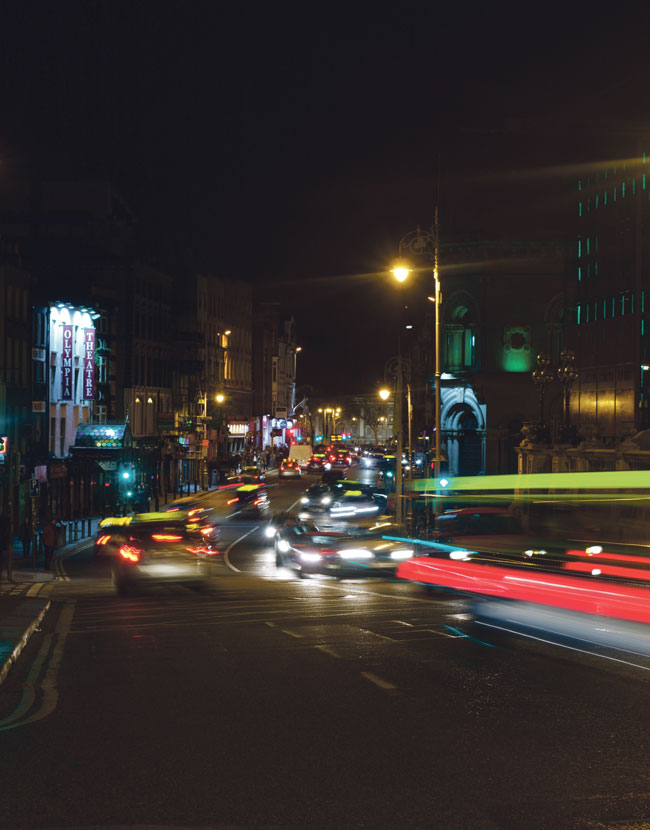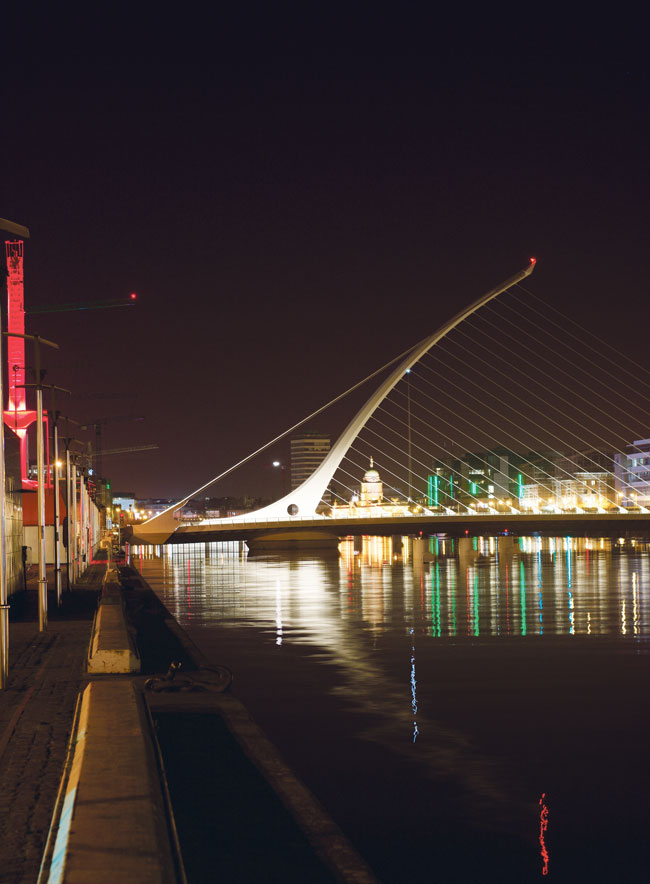
Walking down Grafton St at 3am, Dublin’s most iconic street is almost unrecognisable. The bustling atmosphere that it played host to some hours before is lost, only to be replaced by those using it as a gateway to reach McDonald’s on their way home from a night out. Instead of the uniquely Irish businesses and culture that the street is home to, one only notices the passage that it provides for rickshaws from one side of the city to the other, and the startling number of homeless people that are forced to take shelter in its shop fronts. The hardest thing to ignore, however, is the potential that this street has to prosper in the early hours of the morning.
Dublin’s economy currently stands in a far stronger position than it did a number of years ago. Unemployment levels have dropped dramatically in Ireland, and last year saw the country’s GDP grow by 5.2 per cent, making it the Eurozone’s fastest growing economy. As the city’s economy continues to thrive, however, its nighttime economy stands stagnant, with Dublin lying dormant through the night hours, wasting time in which its economy could continue to grow.
Countless cities throughout the world prove the potential of a 24-hour economy, with cities such as London, Berlin, Amsterdam, New York, Mumbai and Tokyo aptly demonstrating that a 24-hour city is not one that simply parties longer. It is instead one that has a diverse and varied economy that caters for a wide range of its citizens’ needs. The advantages of an economy of this kind are vast and far-reaching. Most obviously, the creation of jobs is but one benefit that is highly appealing, while a 24-hour economy also offers opportunity for local businesses to diversify. Not only that, cities of this nature experience higher levels of security, and the transport systems that develop in order to support the city create a fast-paced atmosphere in which citizens’ lives are not curtailed by conservative timetables. It can also be said that the success of a nighttime economy is readily transferable, with other sectors, such as tourism, benefitting as a result.
Dublin holds the potential to recognise the demand that is steadily increasing for a broader nighttime culture, as opposed to one which is centred around the consumption of alcohol
Ireland’s tourism sector, in particular, stands to benefit from the development of a nighttime economy. According to the Irish Tourist Industry Confederation, Irish tourism experienced a particularly strong year in 2016, with the industry being worth €8 billion euro to the Irish economy. Figures also show that the number of international visitors increased by 10 per cent to 8.8 million. Indeed, Dublin continues to prove itself capable of marketing its unique culture and heritage in a way that appeals to an international market. A 24-hour economy would provide a platform to propel this sector into even greater levels of success.
That is not to say, however, that challenges do not present themselves to cities that try to expand their economy in this way. Working conditions at night are not always conducive to wellbeing, and there are a number of factors that must be considered for the positive development of a city’s nighttime economy, including investing in suitable lighting and transportation systems. More long-term challenges take the form of expanding infrastructure and providing cultural education. While a well-implemented nighttime economy can both boost the financial prospects of a city and foster a sense of community, a poorly enforced system can lead to anti-social behaviour and alcohol-fuelled violence.
London has recently made efforts to strengthen its prospects as a 24-hour city, with the ongoing investments made by the Mayor of London, Sadiq Khan, proving the worthwhile nature of prioritising the development of an economy of this kind. The establishment of London’s Night Time Commission seeks to oversee the economic and cultural regeneration of London’s nighttime economy, while the positions of Night Czar and Chair of the Night Time Commission will be held accountable for delivering a vision of London as a 24-hour city, by working directly with local businesses, authorities, the Metropolitan Police and Transport for London (TFL). The implementation of the night-tube, with further promises of expanding the service, is already telling of the commitment of the commission to developing its 24-hour economy.
London is just one of many cities to appoint a night mayor, following the example set by Amsterdam. The position was originally created in the Dutch capital in 2014, with Paris, Toulouse and Zurich quickly following suit. Mirik Milan, former club promoter and current night mayor of Amsterdam, is dedicated to developing the city’s nighttime economy in concentrated areas. Through manageable changes, such as extending the hours that clubs can stay open for in order to avoid a rush of people vacating the building together at a specific point in the night, Milan is also mindful of the residents of the city, and how the expansion of the 24-hour city can benefit them, instead of causing harm.

While these incredibly feasible and logical approaches to the expansion of nighttime economies are taking place both in London and across the globe, it is evident that Dublin must take the opportunity that its currently healthy economy has presented itself with, and reevaluate its priorities of expansion and growth. In this move, Dublin holds the potential to recognise the demand that is steadily increasing for a broader nighttime culture, as opposed to one which is centred around the consumption of alcohol. As it currently stands, aside from pharmacies and petrol stations, there are very few business that remain open into the early hours of the morning other than bars and nightclubs.
It is unsurprising, therefore, that alcohol-consumption levels in Ireland remain incredibly high. According to a study by Alcohol Action Ireland (AAI) on alcohol consumption in 2016, per capita levels stood at 11.46 litres of pure alcohol per person aged 15 and over, which presented an increase of 4.8 per cent from 2015, when it was 10.93 litres. As our consumption of alcohol continues to rise, a fundamental shift in the way Irish people think about their leisure time could be conducive to a change in Irish attitudes to alcohol. The creation of late-night arts and culture festivals in areas such as theatre and food would present an opportunity for Dublin’s residents to engage with a nighttime activity which does not have a focus on alcohol. The success of pop-up festivals throughout the city, such as Eatyard in Rathmines, prove that there is demand present in the city for more creative and urban dining experiences.
This demand for later opening hours in Dublin’s food sector has not gone unnoticed, with various eateries extending their hours in order to capitalise on the needs of their customers. The likes of Sicilian pastry shop, Dolce Sicily, on Dawson St recognised the potential that later opening hours offered to their business, and decided to respond accordingly. The café now stays open until 9pm from Thursday to Saturday, while remaining open until 8.30pm throughout the rest of the week. Speaking to The University Times, Camilla Raparo of Dolce Sicily was happy to discuss the café’s recent change in opening hours, explaining that the original change took place as a result of the rush during Christmas time. “We just started before Christmas because we thought it would be a good time of the year to do so, as it is very busy, and to stay open a bit longer because people are shopping. And then we saw that it was going well, and we kept it like this.”
However, these extended opening hours are not just a response to demand. They also act as a reflection of traditional Italian culture: “We also wanted to do it because in Italy it is is very popular to go before dinner for a drink and nibbles, and so we wanted to do the same here.” In bringing this Italian tradition to Dublin, Dolce Sicily not only prove the demand in Ireland for later opening hours. They also prove the potential of the city to become more international.
Although more readily available options for nighttime leisure activities of this kind would be a welcomed addition to Dublin’s nighttime economy, it cannot be denied that clubs and bars would continue to present themselves as a staple in this 24-hour city, as is the case in cities such as Berlin and Amsterdam. In 2015, Amsterdam’s mayor, Eberhard van der Laan, approved 24-hour permits for three of the city’s nightclubs, bringing the total number of venues with 24-hour permits in Amsterdam to five. Remaining open around the clock, these nightclub’s opening hours would very much be the envy of Dublin party goers as they walk down Grafton St at 2am or 3am, their nights having been prematurely cut short by early licenses.
The potential that a 24-hour economy could present to the city of Dublin over the years to come cannot be ignored
Fundamental to the success of this kind of nightlife, however, is a reliable and well-established transport system. Over the past number of weeks, Irish transport systems have continued to prove their instability in the face of adversity, as the Bus Éireann worker’s strikes over the company’s handling of their financial difficulties continue to leave a number of citizens stranded. This culminated in last Friday morning’s unprecedented transport strikes from Dublin Bus, DART and train services throughout the country. The city’s attempts to upgrade its transport system in recent times have also been problematic, as the addition of the Cross City Luas line continues to cause upset throughout the city centre. In order to support a 24-hour economy, changes would have to be made to the direction currently maintained by Dublin’s transport services.
Along with London’s 24-hour tube service, there are countless models throughout the world that offer examples of successful 24-hour transport links. New York’s subway system is committed to providing a 24-hour transit across the city, while Denmark’s subway system, which opened in 2002, offers nighttime transport from driverless trains, which dramatically reduces costs. While it is difficult to compare the infrastructure of New York to Dublin, Dublin should take note of the commitment made by New York to its 24-hour economy, considering the number of nights that are cut short throughout the city by that one member of the group proclaiming that they have to leave for the last bus.
In light of the important role that a transport system has to play in a thriving nighttime economy, it becomes particularly obvious that a successful 24-hour economy is dependent on a number of bodies within the city working harmoniously together in order to achieve a common goal. This may involve collaboration between the private and public sector, presenting countless opportunities not only for those involved within the sectors to grow, whilst also establishing a sense of community between these partners that would otherwise not be achieved. Although it cannot be denied that an unpredictably turbulent time lies ahead for Ireland’s economy in light of Brexit, the potential that a 24-hour economy could present to the city of Dublin over the years to come cannot be ignored.






